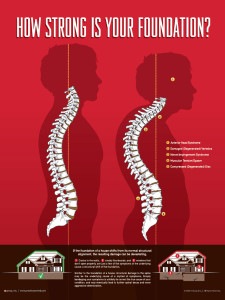How Strong is Your FOUNDATION?
People often ask me what I mean, when I say that “I work with the foundational segments of the spine”. Generally they think that i’m referring to the pelvis, low back or even the feet. In all honesty if you guessed those areas you’d be wrong, sorry to break it to you. When we look at a stationary structure like a house for example we know that the foundation is at the base.
A strong LEVEL foundation is the key to building a strong house that will stand the test of time…

In fact this phase of building construction is so important that an inspector must come in and sign off before the framing and walls are constructed. If this foundation were to shift an inch on one side it would stand to reason that you might notice the floor boards creaking, the drywall cracking and windows and doors sticking. It would also stand to reason that if the problem were left uncorrected then even the roof might be affected. All of these problems with the house are called secondary conditions. They are direct results of the underlying foundational displacement. You can nail down the floorboards, spackle the walls, and oil the window and door jams, but is this going to correct the problem? Eventually these secondary problems are going to keep coming back. If this were your house what would you do? You would probably have a foundational expert come in and level the foundation, then with some work on those secondary conditions you would be back in business.
The human body is no different then your house, it has a foundation and when that foundation isn’t level a number of secondary conditions can result. However, being that humans are not grounded in one place like a house our foundation is not where you might think. We are dynamic with internal structures that are constantly trying to keep us standing up straight and level, no matter what we are doing or what position we’re in, whether Its sitting, standing, running etc.
The foundation of the human body is located in the upper neck…

This might sound kind of awkward but the foundation in humans isn’t found anywhere near the ground. Its located at the top of the neck, the top two bones called the Atlas and Axis. On top of these bones sits the skull and brain. Think of the skull as the house sitting on top of the foundation (atlas and axis). Inside the skull we have different structures of our anatomy that help to keep us balanced (level), standing up straight and position or body parts in space.
Think of these structures as a collection of BUBBLE LEVELS…
You know like the kind you buy at your local home improvement store. Accept that these bubble levels (your brain) are constantly trying to keep themselves upright and balanced. This is known as mechanoreceptive afferentation. In other words it’s the constant INPUT of information from muscles, joints and tendons regarding positional sensation INTO the central nervous system or brain, then the direct OUTPUT of information back to those muscles, joints, and tendons to keep us up right.
All this information is relayed to different organs of proprioception or parts of the bubble level that tell us were we are in space. These structures include the eyes (righting reflex), labyrinth (inner ear), and the cerebellum and cerebrum (structures of the brain). They receive this information, process it and relay it out to the muscles, joints and tendons to move your body so you stand up straight and hold your balance. This happens at an incredible rate with information moving in and out. You don’t even realize its happening but if you’ve ever tried to balance on one foot for a period of time then you’ve felt it first hand.

When a segmental displacement or Atlas Displacement has occurred in the upper neck it throws off this entire system. In other words when the foundational segments have displaced, it shifts the skull, throwing off the “Bubble Levels”. This means the brain isn’t getting the proper signals it needs from muscles, joints and tendons in order to convey information back out to the rest of the body to keep you up right. If the problem is really bad someone might experience a secondary condition like dizziness or vertigo.
Garbage IN = Garbage OUT
The biggest point to remember is that the quality of information going INTO the brain is just as important as the quality of information going OUT of the brain, in fact they are directly related to one another. An atlas displacement complex will affect the movement of information and may contribute to a number of secondary conditions such as balance, problems, external structural distortions and muscular imbalances.


